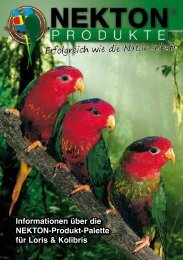Create successful ePaper yourself
Turn your PDF publications into a flip-book with our unique Google optimized e-Paper software.
The two families differ in their reproduction<br />
behaviour as well. The female sunbird is<br />
again the nest-builder at all stages, even if<br />
records do show that the male occasionally<br />
makes a slight contribution in collecting<br />
material for the elongated, purse-shaped<br />
nest with its side entrance.<br />
Incubation is the sole province of the female.<br />
The male maintains a vigil nearby while<br />
the female is incubating the two elongated,<br />
light-coloured eggs with the dark flecks near<br />
the poles. Chicks take about 13 - 20 days to<br />
hatch depending on the ambient temperature.<br />
After hatching, the male becomes a truly<br />
active partner and helps the female to feed<br />
the young during the 2 - 3-week nestling period.<br />
The male sunbird may not be the most<br />
perfect husband and father, but compared<br />
to the humming bird he is a faithful and true<br />
partner.<br />
These lively little birds are winning the hearts<br />
of more and more bird lovers and due to the<br />
simplified care available today will surely<br />
continue to grow in popularity.<br />
Basic Rules for<br />
Keeping Sunbirds<br />
The number of aviculturists who have taken<br />
up keeping this brilliantly coloured and lively<br />
group of birds has grown considerably in the<br />
past few years. This can be explained by the<br />
fact that we now know more about the habits<br />
and requirements of sunbirds, and, what is<br />
more, have distinctly improved means of feeding<br />
these birds at our disposal today.<br />
As sunbirds are rather more robust and less<br />
complicated in their care than humming<br />
birds, many bird lovers prefer to try their<br />
hand at collecting them first. It should not be<br />
forgotten, however, that all they have in common<br />
is their basic diet - nectar, pollen and<br />
insects.<br />
Although sunbirds cannot be included in the<br />
gregarious types of bird families they are<br />
by far less quarrelsome and incompatible<br />
among themselves than humming birds, and<br />
different species can be kept together in one<br />
aviary or a species in pairs in cages, provided<br />
they are large enough. Sunbirds are very<br />
active birds, always on the move examining<br />
all the crevices and corners of their territory,<br />
so they need plenty of space to keep them<br />
happy. The cage should not be smaller than<br />
L150 x B50 x H80cm. Decorate the inside of<br />
the cage with twigs, not forgetting of course<br />
to leave enough room for the birds to spread<br />
their wings. NEKTON drinking tubes, obtainable<br />
in any reputed pet store, should be<br />
used to administer the nectar solution. Place<br />
the feeders in locations easily reached by the<br />
sitting birds. Bath bowls can be installed either<br />
at higher levels, as for humming birds,<br />
or on the floor of the aviary or cage. Again<br />
cat litter has proved the most suitable floor<br />
covering.<br />
The African members of the sunbird family<br />
can best be recommended for people just<br />
starting to keep these bright birds with their<br />
jaunty ways. These species are comparatively<br />
easy to obtain, and the following types<br />
are not only more robust but also interesting<br />
and attractive: the Yellow-Bellied Sunbird<br />
(Nectarinia venusta), the Scarlet-chested<br />
Sunbird (Nectarinia senegalensis), the<br />
Marico Sunbird (Nectarinia mariquensis) and<br />
the Beautiful Sunbird (Nectarinia pulchella).<br />
Feeding Humming<br />
Birds and Sunbirds<br />
(basically applicable to all other nectar-feeding<br />
birds)<br />
Aviculturists are often reluctant to try keeping<br />
nectar-feeding birds and in particular hummers<br />
or sunbirds, because they think feeding<br />
them is too great a problem. In the past many<br />
bird lovers, particularly those out at work all<br />
day, found it an almost insurmountable problem<br />
to mix up the individual ingredients,<br />
and that twice a day. Our team of products<br />
- NEKTAR-PLUS, DESI-PLUS and NEKTON<br />
feeders - now reduces this problem to sensible<br />
proportions and makes these worries<br />
melt away. Properly used, these three products<br />
ensure correct and healthy feeding.



